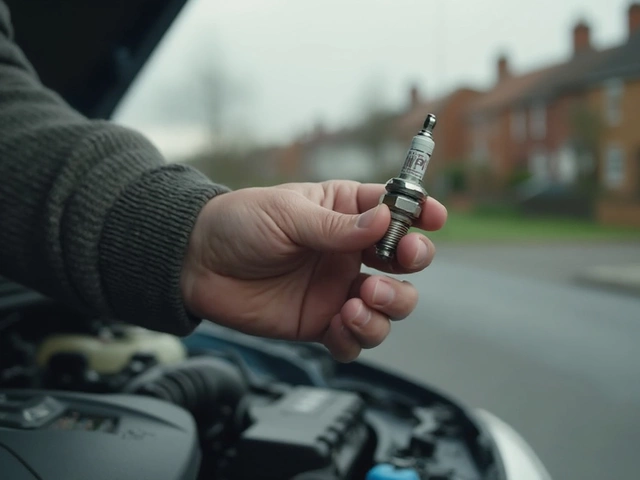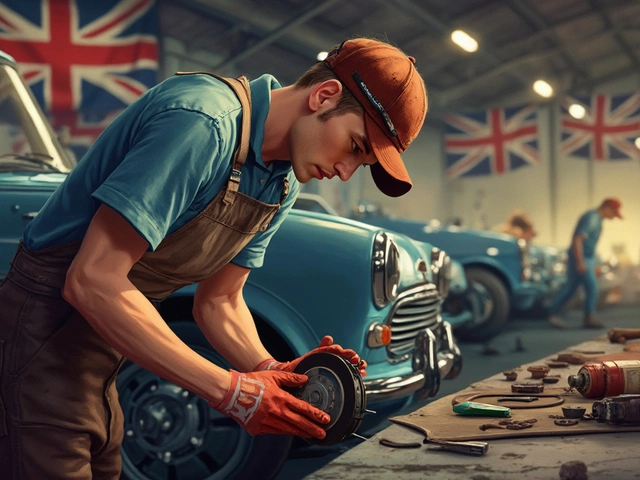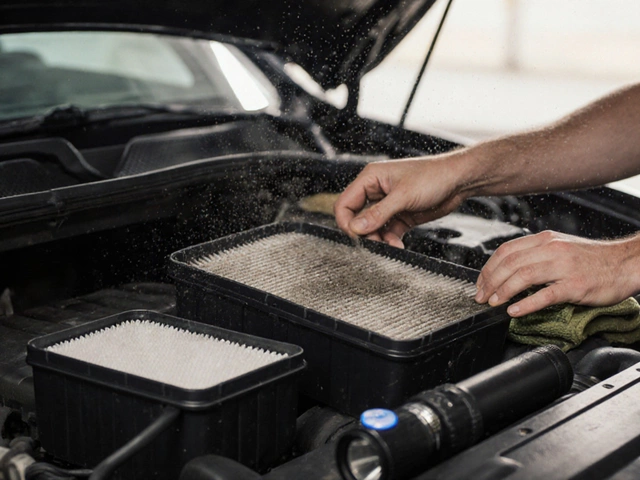Car radiators are crucial for maintaining the optimal temperature of your engine. They disperse heat away from the engine, ensuring it doesn’t overheat during those long drives or sweltering summer days. When a radiator starts failing, it's important to address the issue quickly to avoid more significant car troubles down the road.
For many, the thought of replacing a radiator can feel overwhelming. However, with a bit of courage, patience, and the right guidance, you might find it a task that's within your reach. This article guides you through understanding when a radiator might be up for replacement and what that process entails. If you've ever considered rolling up your sleeves and handling some car maintenance yourself, this could be the perfect starting point!
- Understanding the Role of the Radiator
- Signs Your Radiator Needs Replacement
- Tools and Preparation
- Step-by-Step Radiator Replacement
- Common Mistakes and Tips for Success
Understanding the Role of the Radiator
When it comes to keeping your vehicle's engine running smoothly, one of the unsung heroes under the hood is the car radiator. It plays a key role in the cooling process by transferring the excess heat from the engine out into the environment. But how exactly does this magic happen? Radiators work by circulating coolant, a mix typically made of water and antifreeze, through the engine block and back to the radiator. Here, the heat from the engine is transferred to the coolant, which is then cooled by the air flowing through the radiator's metal fins. This cycle repeats, keeping the engine at an optimal temperature. If not for the radiator, an engine would overheat, leading to permanent damage or even catastrophic failure.
Understanding the nuances of how a radiator functions is crucial for anyone considering tackling this type of car maintenance. The thermostat, hoses, and fans all play supporting roles in this process. The thermostat regulates when the coolant should be released. The hoses provide essential pathways for the coolant to flow between the engine and the radiator. Meanwhile, the fans help move air across the radiator fins, aiding the cooling process. An understanding of these components not only equips you better for a DIY car repair like radiator replacement, but also helps diagnose problems before they escalate. For instance, hoses with visible cracks or leaks might not seem significant but can contribute to engine overheating, as they compromise the system's ability to keep coolant properly circulated.
Let's not overlook the history and pivotal moments in the evolution of radiators in automobiles. While early cars used simple systems, innovations over the decades have led to the creation of today’s highly efficient models. A striking statistic from the Automobile Cooling Institute highlights that modern radiators are at least 25% more efficient than their earlier counterparts, thanks in part to advancements in materials and design. The use of aluminum and plastic makes today's radiators both lightweight and highly effective. These improvements have contributed significantly to the development of high-performance vehicles, which consistently churn out more heat than older models due to their increased power output.
"The radiator's role extends beyond mere cooling; it is integral to maximizing engine performance and longevity," says renowned automotive engineer David Clarkson. "Without it, we'd see not only a rise in maintenance costs but also a decrease in vehicle reliability."This perspective underscores the importance of regular check-ups on your radiator’s condition. For those who hear rattling sounds or notice a puddle of coolant under the car, it's not just an inconvenience; it’s a potential warning sign. Regular coolant checks, radiator flushes, and hose inspections can prevent minor issues from becoming expensive repairs.
Signs Your Radiator Needs Replacement
The radiator plays a pivotal role in your vehicle's cooling system. A failing radiator can lead to engine overheating, which is something every car owner dreads. So, how do you know when your car's radiator is on its last legs? There are several telltale signs that might indicate that it's time for a replacement. It's essential to be vigilant about these symptoms to avoid more extensive and costly repairs down the line.
One of the first signs of a faulty car radiator is an overheating engine. If you notice the temperature gauge needle inching towards the red zone more often than not, your radiator might not be dispersing heat efficiently. Overheating is not something to ignore, as it can cause severe damage to your engine, leading to warped components and a seized engine block. Addressing an overheating issue promptly can save you from these catastrophic outcomes.
Another indicator is the presence of coolant under your vehicle. This suggests a leak, which could be occurring due to a crack or hole in the radiator. Even a slow drip of coolant should not be overlooked, as it can quickly escalate into a more significant problem. Check your driveway or garage floor for green, yellow, or orange stains; these are typical colors of antifreeze, and they hint at a problem that needs investigating.
A third sign is discolored or rusty coolant when you check the levels. Coolant is typically bright and clear, so if it turns a rusty brown, it might suggest corrosion within the radiator. This corrosion can impede the radiator’s performance, leading to blockages that prevent coolant from flowing as it should. This is especially common in older vehicles or those subjected to harsh winter conditions without appropriate coolant mixtures.
Beyond visual checks and temperature readings, it's beneficial to listen to your car as well. Strange noises, such as a rattling or knocking sound from the front end, can be indicative of a problem within the cooling system itself. It's not uncommon for debris to become lodged in the radiator fins or for loose parts to rattle. Paying attention to these noises can let you catch problems before they escalate.
"Regular maintenance can't be overstated," says James O'Keefe, a seasoned auto mechanic with over 25 years of experience. "Vehicles naturally wear and tear over time, and radiators are no exception. Addressing small issues early can prevent bigger ones later."
A final sign of radiator distress can be an inexplicably low coolant level. If you're constantly topping up your coolant, yet your engine remains troublesome, this could be a sign of a fault somewhere. Look for evidence of coolant mixing with engine oil, which can appear as a milky substance on the oil cap or dipstick. This points to a serious problem, like a blown head gasket, which can lead to further damage if the radiator isn't functioning correctly.
In some cases, replacing your car radiator can be straightforward – simply remove the old unit and install a new one, provided you have the right tools. However, considering the potential complexity and risks involved, this task might best be left to professionals, especially if you're not confident in your DIY skills. Whether you choose to replace it yourself or seek expert assistance, understanding these signs and acting upon them is critical for your car's longevity and reliability.
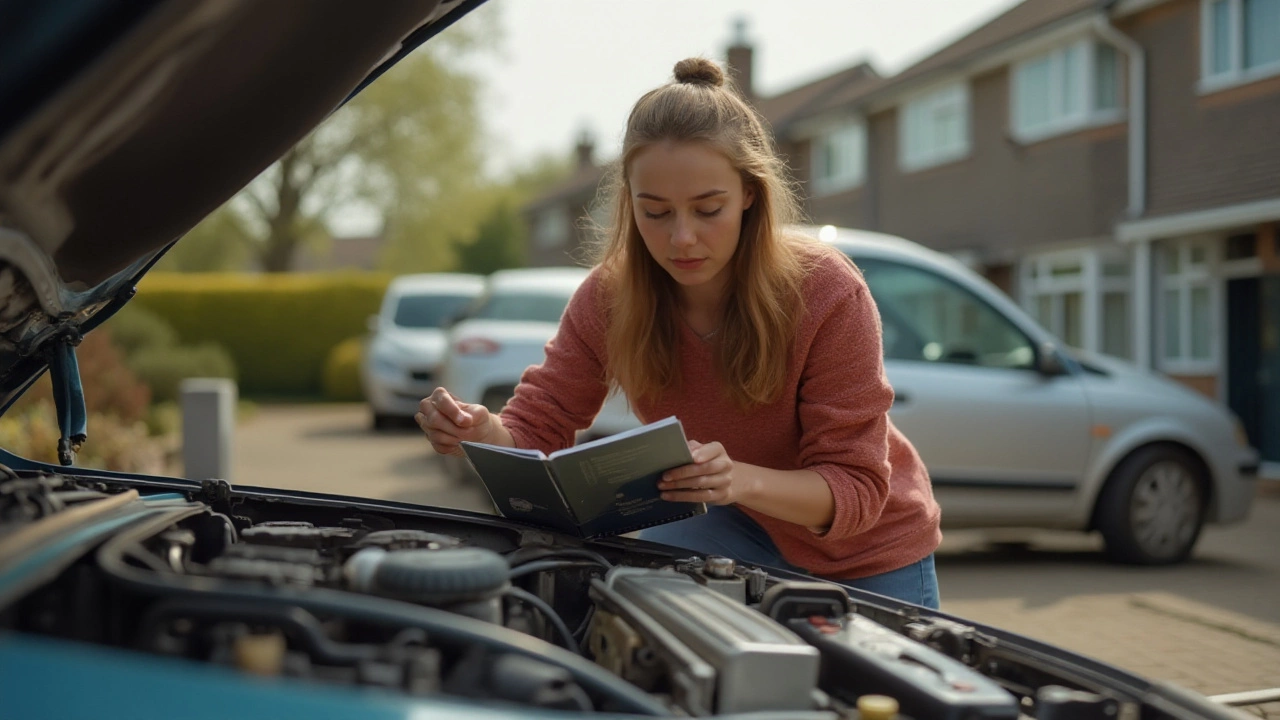
Tools and Preparation
Embarking on the journey of replacing a car radiator demands not just determination, but also the right set of tools and a prepared mindset. Let's face it, the process can get messy and a tad complex if you're not properly equipped. Before you pop open that hood and dive into the world of engine coolant and hoses, making sure you have everything in place is a must. A seasoned mechanic might find the task routine, but for a DIY enthusiast, preparation is the name of the game.
The first thing you need is an understanding of what tools are necessary. At the very least, your toolkit should include a socket wrench set, screwdrivers, a pair of pliers, and an antifreeze catcher. Next, make sure to have a drain pan handy to collect old coolant, as spilling it all over your driveway is not the best idea. Safety is paramount, so gloves and safety goggles are essential to protect your hands and eyes from potential hazards. Replacing a radiator also involves handling sharp components and chemical fluids, so these precautions are non-negotiable.
Preparation involves more than just tools; knowledge about your specific vehicle is equally vital. Radiators can vary significantly between makes and models, which means consulting your vehicle's manual is a good start. This will offer insight into radiator placement, specifics about bolt sizes, and other crucial details. If you're unsure about something, referring to online forums or even watching video tutorials tailored to your car can be incredibly beneficial. As a famous auto enthusiast, ChrisFix, once said,
"Preparation is key. Spend more time preparing and you'll spend less time fixing mistakes later."
Let's not forget the importance of having replacement parts ready. This includes not only the radiator itself but also any additional components like hoses or clamps that might need replacing during the swap. It's usually a good practice to replace the radiator cap and hoses simultaneously since they might wear out at the same rate as the radiator. Having all these components on hand will save you multiple trips to the auto parts store, which can disrupt the workflow and make the task feel endlessly strenuous.
The final aspect of preparation is creating a workspace that's conducive to the task at hand. A well-lit, spacious area is ideal, as it allows you to lay out your tools and parts logically. Also, having a clear idea of the sequence in which you'll proceed can make the entire process flow smoother. Don't overlook documenting your steps, especially if you're new to this. Taking pictures at each stage can be invaluable when reassembling everything back together. In DIY car repairs, the smoothness of a task is largely dependent on how well each step is prepared in advance.
Step-by-Step Radiator Replacement
So, you've decided to take the plunge and replace your car radiator on your own. While it may seem daunting at first, with the right guidance, it can be a rewarding experience that saves you both time and money. First things first, you'll need to get your tools together. Usually, you'll require a wrench set, a screwdriver, a drain pan for catching coolant, and perhaps some gloves to keep your hands clean and safe. Make sure you have a clean and organized workspace, too; you'll be thankful for it later when you're looking for that one runaway bolt. It's wise to start by disconnecting the battery, ensuring there's no power running through the system while you're working on it. This precaution might seem basic, but it's critical for safety reasons.
Next, you'll want to drain the coolant from the radiator. Place your drain pan under the radiator's drain valve (the petcock) and open it up. Give it some time to fully drain, and once it's empty, close the drain valve. Remove any parts that might obstruct your path to the radiator. This could mean anything from the air filter assembly to some hoses that connect to the radiator itself. Make a note of where everything is before you start taking things apart, and if you're prone to forgetting, snap a quick picture with your phone for future reference. It's also helpful to label smaller parts as you remove them, ensuring a smoother reassembly process later on.
Once you have clear access to the radiator, you'll be unfastening it from the engine bay. Depending on your vehicle, you may find four or more bolts securing the radiator in place. As you remove these bolts, gently lift the radiator out of its place, being cautious of any remaining hoses that might still be connected. At this point, it might feel a bit like extracting a delicate piece of machinery from a puzzle. Just take your time. An interesting stat here is that nearly 30% of radiator replacements are botched due to improper handling. So, to avoid unnecessary damage, have a friend help you if the radiator feels too cumbersome. They can support either side as you lift.
Before installing the new radiator, take this opportunity to inspect the surrounding area. Look for any signs of rust or wear on the brackets that support the radiator. Replace these if any look suspect. For the new radiator, ensure that it matches the specifications of the old one. Check that the mounting points align and that no connections pose any blockage issues. Place the new radiator into position and secure it with the bolts you removed earlier. It's essential to get a snug fit, but avoid overtightening them. Over-tightening might lead to stress fractures in the mounts, something you'd want to steer clear of.
After securing your new radiator, reattach all hoses and parts exactly the way they were. This is where those earlier snapshots come in handy. Take care to tighten hose clamps securely, as a loose hose could lead to leaks, devastating your engine's health if left unchecked. Another thing to remember is to refill the radiator with fresh coolant, consulting the vehicle's manual for the correct type and mixture ratio. Start the vehicle and let it idle while keeping an eye on the temperature gauge. Check for leaks and ensure everything is running smoothly. Bring any air pockets to the surface by gently squeezing the radiator hoses as the engine is warming up. With everything set, you should experience the satisfying hum of an efficiently cooled engine.
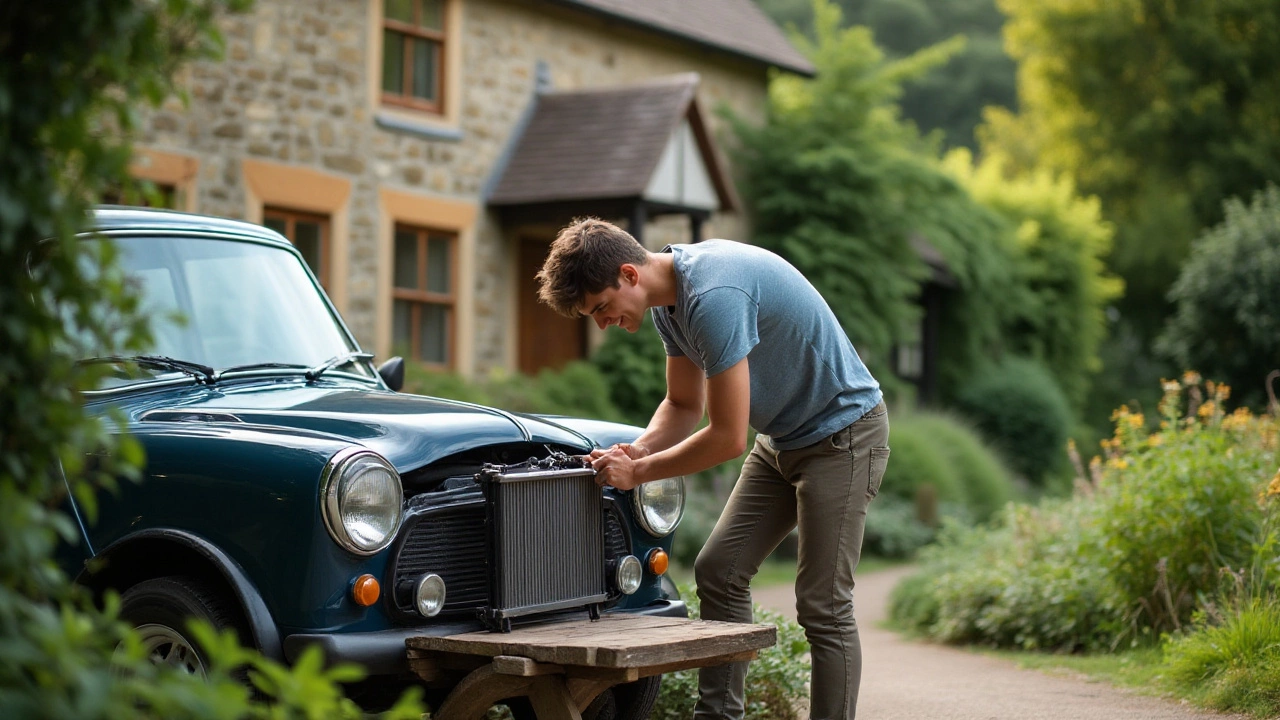
Common Mistakes and Tips for Success
Taking on the task of replacing a car radiator can be exciting for the DIY enthusiast, but there are several common mistakes that can trip you up if you're not careful. One major pitfall is not properly draining the old coolant. Failing to do this thoroughly can lead to spills, which are not only messy but also potentially toxic to both pets and children. It's important to not only drain the coolant but also to dispose of it responsibly in accordance with local regulations, as this helps protect the environment and keeps your workspace clean and safe.
Another error to watch for is neglecting to check the condition of related components. Hoses, belts, and the thermostat all work in concert with the radiator, and replacing the radiator without inspecting these can mean you're leaving a ticking time bomb under the hood. For instance, a compromised hose can burst under pressure, leading to the very overheating problem you sought to fix. It's wise to replace any hoses that appear worn or cracked, ensuring a full-circle approach to your car maintenance.
Incorrect installation is another stumbling block. Proper alignment and fitment are key, as a radiator that isn't secured correctly can cause vibration, inefficient cooling, or even detachment while driving. Referencing the vehicle's repair manual is crucial here, giving you the specifications and diagrams necessary for accurate placement. Taking the time to double-check your work before you button everything back up can prevent a world of headaches down the line.
"Preparation is the key to success," says Avery Black, automotive expert and author of 'Maintain and Thrive: A Guide to Car Longevity'. "Ensuring you have the right parts and tools ready before you start can make the difference between a smooth operation and an ordeal."
It’s worth noting that some car models are more challenging than others, often dictated by the engine's configuration and the radiator's location. For vehicles with less accessible radiators, it's often recommended to consult an expert or at least take increased care with each step. Keep an eye out for especially tight spaces or numerous parts that may need disassembly to access the radiator. Documenting each step can help you reassemble everything correctly.
Lastly, don't forget the test drive after installation. It's easy to feel a sense of accomplishment and call it a day once everything is put back together, but the real test is monitoring your handiwork while on the road. Drive for a few miles, keeping an eye on the temperature gauge, and inspect for any leaks afterward. This final checkup can affirm that your DIY car repair was a success, leaving you with the pride of a job well done and a smoothly running vehicle.


